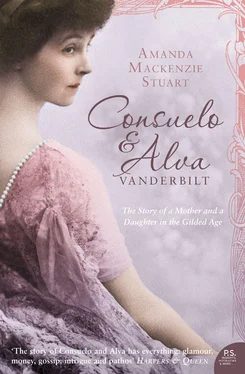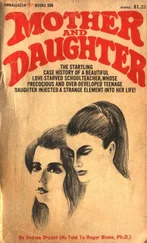Unlike many other members of society, Alva, Consuelo and the Duke of Marlborough returned to Newport on Sunday 8 September. There had been rumours that the Duke was planning to proceed from New York to Lenox, a smart resort in the Berkshires in Massachusetts, but the press noted with interest that this plan had been set aside. The days came and went. Nothing materialised. Impertinent speculation continued. ‘The lingering of the Duke of Marlborough at Marble House must mean something,’ thought Town Topics , ‘and his daily drives with the fair daughter are, in the minds of Newport gossips, convincing proof that America will have another Duchess, and a reigning one of the house of Spencer-Churchill at that.’ 27 By now, the magazine was explicitly linking the presence of the Duke of Marlborough to Alva’s relationship with Oliver Belmont. The Duke of Marlborough, the magazine remarked, ‘seems to be the exclusive property of the Marble House Vanderbilts and the Stone Stable Belmonts’. 28 Moreover, every step was being taken by the aforementioned working in tandem to give the two young people time alone together. ‘While the Duke and Miss Consuela [sic] are driving, you may meet any morning, and again in the afternoon, Mrs Willie and Mr Oliver Belmont wheeling or walking.’ 29
As speculation reached fever pitch, another week passed. It is possible that the Duke of Marlborough, who had an obstinate streak, may have disliked the idea that he was being pressured into a proposal and refused to be rushed; by now he may have noticed that the ferocious Mrs William K. Vanderbilt always succeeded in getting her way and suspected that he was being used as a weapon in her armoury. He may have felt that it was undignified, given Consuelo’s wealth, to propose to her too quickly; and on closer inspection he may have found Miss Consuelo Vanderbilt most difficult to read. For what is one to make of Consuelo?
There were no newspaper reports that she looked unhappy during this courtship, though public sulking and failure to rise to the occasion would have been regarded as almost as insubordinate as eloping with Winthrop Rutherfurd. There were no reports of her looking radiantly happy either, however. In fact there was very little discussion of Consuelo’s demeanour at all. Her name was often misspelt, even by newspapers that had spent weeks tracking every move. There were philosophical debates such as ‘Why Do Women Crave Titles? Are They by Nature Imperialists and Enemies of Democracy?’ 30 Otherwise, it was as if Consuelo scarcely existed. Perhaps that is what she felt too, for Consuelo later spoke of being frightened of risking her mother’s displeasure and of being ‘disciplined and prepared’ 31 for the Duke’s arrival. For his part, the Duke may have found her so inscrutable that he began to doubt whether they were remotely compatible, for even marriages of convenience require a degree of mutual understanding to make them work. The difficulty was that the longer he stayed, the more awkward the position became.
Years later, Alva gave evidence to the Rota – the Catholic court in Rome – that she had precipitated the engagement by announcing it in the newspapers. The Duke of Marlborough told his hosts that he intended to depart during the week beginning 16 September and Alva may have applied pressure by issuing a formal denial of an engagement knowing that he was about to go. ‘New York papers insist upon the engagement of Miss Consuelo Vanderbilt to the Duke of Marlborough. Mrs Vanderbilt said to a reporter of the Daily News that evening “Miss Vanderbilt is not engaged to the Duke of Marlborough. I regret that the papers so often see fit to connect her name with different friends of ours”,’ wrote the Newport Daily News on the morning of Wednesday 18 September. This could have had the desired effect on the same evening, for according to William Gilmour’s records, Alva made a dash to New York on Thursday 19 September, returning the following day. 32 She almost certainly went to New York to put matters in hand for the formal announcement of Consuelo’s engagement on Friday 20 September.
When it came, the proposal itself was undramatic. After dinner on the night before he was supposed to leave, the Duke of Marlborough took Consuelo into the Gothic Room at Marble House, which she famously described as ‘propitious to sacrifice’, and asked her to marry him, saying that he hoped he would make her a good husband. Consuelo ran upstairs to break the news to her mother. ‘There was no time for thought or regrets,’ she said. ‘The next day, the news was out.’ 33 These two short sentences may disguise a moment of real maternal cruelty by Alva however. It is possible that when she told her mother of the Duke’s proposal, Consuelo was still hesitating over whether or not to accept. It is equally possible that Alva simply ignored her daughter’s obvious doubts, and chose to regard the engagement as a fait accompli, leaving for New York as soon as she could to arrange for the announcement. The reaction of Consuelo’s twelve-year-old brother, Harold, did not help. He looked at her calmly and said: ‘He is only marrying you for your money.’ ‘With this last slap to my pride,’ wrote Consuelo, ‘I burst into tears.’ 34
As soon as the engagement was announced a fierce battle began for control of the narrative. The formal announcement on Friday 20 September 1895 immediately triggered a convulsion of publicity. Initially, much of the coverage was deferential, although Alva’s successful direction of the matter attracted some snide remarks. The ‘short but decisive campaign of General Alva’, was congratulated by Town Topics . 35 ‘It was a Famous Victory,’ crowed the World , quoting Southey on the triumph of the 1st Duke of Marlborough at the Battle of Blenheim, in an unexpected outbreak of erudition. 36 Newspapers dedicated several column inches to profiles of the young Duke, ‘Blenheim Castle’ and the Spencer-Churchills, and apart from remarking that he did not seem particularly clubbable, the commentary was superficially polite. Consuelo was described as sweet and cultivated though her ‘youth’ and ‘simplicity’ were consistently underlined. Sometimes this went a little far. As the Newport Journal remarked: ‘Her picture as a girl of ten or twelve years old, wearing a tucked guimpe and a childish gown of white muslin and lace with a baby sash is made to do duty in a full page reproduction as “The Fiancée of the Duke of Marlborough” … and some of the papers are indulging in ill-natured criticism.’ 37 Suspicion about the Duke’s motives was never far from the surface either, even in those newspapers who claimed to despise such cynicism. ‘All doubt as to what impelled the Duke’s visit to this country is dissipated by the announcement of his engagement,’ 38 opined the New York Herald , immediately planting seeds of doubt by mentioning it, and failing to explain why becoming engaged to an heiress in any way cleared the matter up.
Once excitement about the engagement subsided, public attention turned to the scale of the deal. There was a short delay until the Duke of Marlborough’s lawyer arrived from England. ‘The marriage settlements gave rise to considerable discussion. An English solicitor who had crossed the seas with the declared intention of “profiting the illustrious family” he had been engaged to serve devoted a natural talent to that end,’ 39 wrote Consuelo. Although wild sums were discussed in the press – $10 million according to one source, plus an additional $5,000 to pay off the Duke’s creditors – the eventual settlement to the Duke was $2.5 million in $50,000 shares of capital stock of the Beech Creek Railway Company, on which an annual payment of 4 per cent was guaranteed by the New York Central Railway Company, giving him an annual income of $100,000 * . This income, which was very similar in structure and total to Alva’s divorce settlement, was the Duke’s for life, and was guaranteed even if his marriage to Consuelo ended. In a most unusual arrangement, however, which may have reflected some unease on the part of William K. about the motives of his daughter’s fiancé, a comparable sum was settled on Consuelo. William K. agreed to pay her $100,000 a year in four equal quarterly instalments, a sum which almost certainly took account of $50,000 already paid to Alva annually for Consuelo’s upkeep which was now transferred to her on marriage under the terms of the divorce settlement. 40
Читать дальше












